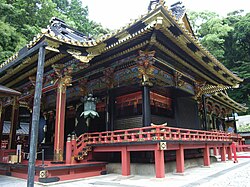Kunōzan Tōshō-gū
| Kunō-zan Tōshō-gū 久能山東照宮 |
|
|---|---|

Haiden of Kunō-zan Tōshō-gū
|
|
| Information | |
| Type | Tōshō-gū |
| Dedicated to | Tokugawa Ieyasu |
| Founded | 1617 |
| Address | 390 Negoya Suruga-ku Shizuoka City |
| Website | www |
|
|
|
The Kunō-zan Tōshō-gū (久能山東照宮?) is a Shintō shrine in Suruga-ku in the city of Shizuoka in Shizuoka Prefecture, Japan. It is the original burial place of the first Shōgun of the Tokugawa Shogunate, Tokugawa Ieyasu, and is thus the oldest of the Tōshō-gū shrines in the country. The main festival of the shrine is held annually on April 17, although its spring festival on February 17–18 is a larger event.
Mount Kunō (216 meters) is a steep peak on Suruga Bay, and the site of an ancient Buddhist temple called Kunō-ji (久能寺?) dating to at least the early Nara period. The temple prospered during the Kamakura period under the famous prelate Enni, who introduced the cultivation of green tea to the region. After the conquest of Suruga Province by the warlord Takeda Shingen, the temple was relocated to what is now Shimizu-ku, and the mountain top fortified into a mountain castle (Kunō-jo (久能城?). After the fall of the Takeda clan, Suruga Province came under the control of the Tokugawa clan.
...
Wikipedia
